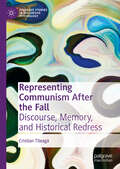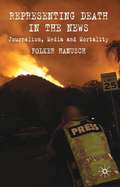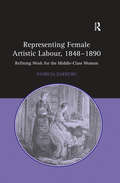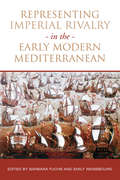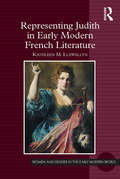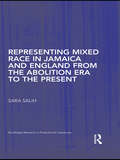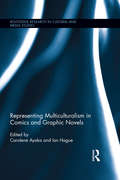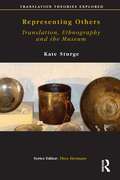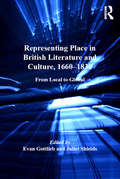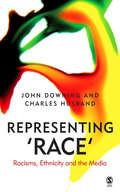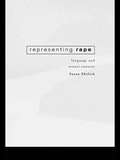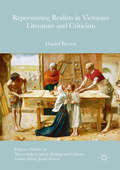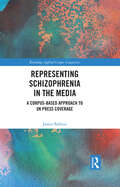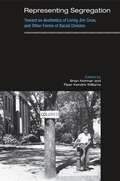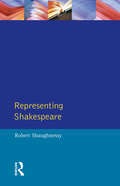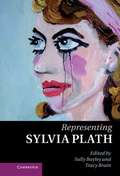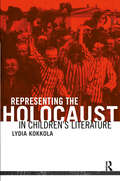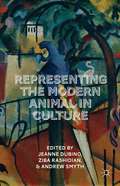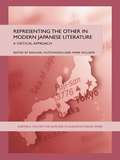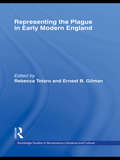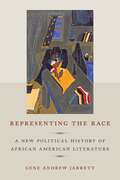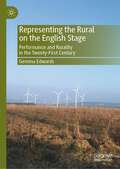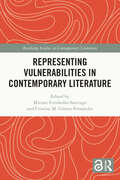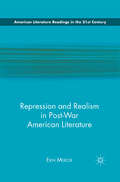- Table View
- List View
Representing Communism After the Fall: Discourse, Memory, and Historical Redress (Palgrave Studies in Discursive Psychology)
by Cristian TileagăThis book explores the contribution of discursive psychology and discourse analysis to researching the relationship between history and collective memory. Analysing significant manifestations of the moral vocabulary of the Romanian transition from communism to democracy, the author demonstrates how discursive psychology can be used to understand some of the enduring and persistent dilemmas around the legacy of communism. This book argues that an understanding of language as an action-oriented, world-building resource can fill an important gap in the theorizing of public controversies over individual and collective meaning of the recent (communist) past. The author posits that discursive social psychology can serve as an intellectual and empirical bridge that can overcome several of the difficulties faced by researchers working in transitional justice studies and cognate fields. This reflective book will appeal to students and scholars of transitional justice, discursive psychology, memory studies, and the sociology of change.
Representing Death in the News
by Folker HanuschThis new study maps and synthesizes existing research on the ways in which journalism deals with death. Folker Hanusch provides a historical overview of death in the news, looks at the conditions of production, content and reception, and also analyzes emerging trends in the representation of death online.
Representing Female Artistic Labour, 1848–1890: Refining Work for the Middle-Class Woman
by Patricia ZakreskiPatricia Zakreski's interdisciplinary study draws on fiction, prose, painting, and the periodical press to expand and redefine our understanding of women's relationship to paid work during the Victorian period. While the idea of 'separate spheres' has largely gone uncontested by feminist critics studying female labour during the nineteenth century, Zakreski challenges this distinction by showing that the divisions between public and private were, in fact, surprisingly flexible, with homes described as workplaces and workplaces as homes. By combining art with forms of industrial or mass production in representations of the respectable woman worker, writers projected a form of paid creative work that was not violated or profaned by the public world of the market in which it was traded. Looking specifically at sewing, art, writing, and acting, Zakreski shows how these professions increasingly came to be defined as 'artistic' and thus as suitable professions for middle-class women, and argues that the supposedly degrading activity of paid work could be transformed into a refining experience for women. Rather than consigning working women to the margins of patriarchal culture, then, her study shows how representations of creative women, by authors such as Elizabeth Barrett Browning, Dinah Craik, Charles Dickens, Anthony Trollope, and Charlotte Yonge, participated in and shaped new forms of mainstream culture.
Representing Imperial Rivalry in the Early Modern Mediterranean
by Emily Weissbourd Barbara FuchsRepresenting Imperial Rivalry in the Early Modern Mediterranean explores representations of national, racial, and religious identities within a region dominated by the clash of empires. Bringing together studies of English, Spanish, Italian, and Ottoman literature and cultural artifacts, the volume moves from the broadest issues of representation in the Mediterranean to a case study - early modern England - where the "Mediterranean turn" has radically changed the field.The essays in this wide-ranging literary and cultural study examine the rhetoric which surrounds imperial competition in this era, ranging from poems commemorating the battle of Lepanto to elaborately adorned maps of contested frontiers. They will be of interest to scholars in fields such as history, comparative literary studies, and religious studies.
Representing Judith in Early Modern French Literature (Women And Gender In The Early Modern World Ser.)
by Kathleen M. LlewellynAlthough attention to the Book of Judith and its heroine has grown in recent years, this is the first full-length study to focus on adaptations of the Bible’s Old Testament Book of Judith across a range of literary genres written in French during the early modern era. Author Kathleen Llewellyn bases her analysis on references to Judith in a number of early modern sermons as well as the ’Judith’ texts of four early modern writers. The texts include two theatrical dramas, Le Mystère de Judith et Holofernés (c. 1500), believed to have been written by Jean Molinet, and Le Miroir des vefves: Tragédie sacrée d'Holoferne & Judith by Pierre Heyns (1596), as well as two epic poems, La Judit (1574) by Guillaume de Salluste Du Bartas, and Gabrielle de Coignard’s Imitation de la victoire de Judich (1594). Llewellyn’s goal is to see Judith as she was envisioned by early modern French writers and their readers, and to understand how the sixteenth century shaped their view of the heroine. Noting aspects of that story that were emphasized by sixteenth-century authors, as well as elements that those writers altered to suit their purposes, she also examines the ways in which writers of this era made use of Judith’s story as a means to explore interests and concerns of early modern writers, readers, and spectators. Representing Judith in Early Modern French Literature provides a deeper understanding of early modern ideas regarding the role of women, the use of exemplary stories in preaching and teaching, theories of vision, and the importance of community in Renaissance France.
Representing Mixed Race in Jamaica and England from the Abolition Era to the Present
by S. SalihThis study considers cultural representations of "brown" people in Jamaica and England alongside the determinations of race by statute from the Abolition era onwards. Through close readings of contemporary fictions and "histories," Salih probes the extent to which colonial ideologies may have been underpinned by what might be called subject-constituting statutes, along with the potential for force and violence which necessarily undergird the law. The author explores the role legal and non-legal discourse plays in disciplining the brown body in pre- and post-Abolition colonial contexts, as well as how are other bodies and identities – e.g. black, white are discursively disciplined. Salih examines whether or not it’s possible to say that non-legal texts such as prose fictions are engaged in this kind of discursive disciplining, and more broadly, looks at what contemporary formulations of "mixed" identity owe to these legal or non-legal discursive formations. This study demonstrates the striking connections between historical and contemporary discourses of race and brownness and argues for a shift in the ways we think about, represent and discuss "mixed race" people.
Representing Multiculturalism in Comics and Graphic Novels (Routledge Research in Cultural and Media Studies)
by Carolene Ayaka and Ian HagueMulticulturalism, and its representation, has long presented challenges for the medium of comics. This book presents a wide ranging survey of the ways in which comics have dealt with the diversity of creators and characters and the (lack of) visibility for characters who don’t conform to particular cultural stereotypes. Contributors engage with ethnicity and other cultural forms from Israel, Romania, North America, South Africa, Germany, Spain, U.S. Latino and Canada and consider the ways in which comics are able to represent multiculturalism through a focus on the formal elements of the medium. Discussion themes include education, countercultures, monstrosity, the quotidian, the notion of the ‘other," anthropomorphism, and colonialism. Taking a truly international perspective, the book brings into dialogue a broad range of comics traditions.
Representing Others: Translation, Ethnography and Museum (Translation Theories Explored)
by Kate SturgeCultural anthropology has always been dependent on translation as a textual practice, and it has often used 'translation' as a metaphor to describe ethnography's processes of interpretation and cross-cultural comparison. Questions of intelligibility and representation are central to both translation studies and ethnographic writing - as are the dilemmas of cultural distance or proximity, exoticism or appropriation. Similarly, recent work in museum studies discusses problems of representation that are raised by ethnographic museums as multimedia 'translations'. However, as yet there has been remarkably little interdisciplinary exchange: neither has translation studies kept up with the sophistication of anthropology's investigations of meaning, representation and 'culture' itself, nor have anthropology and museum studies often looked to translation studies for analyses of language difference or concrete methods of tracing translation practices. This book opens up an exciting field of study to translation scholars and suggests possible avenues of cross-disciplinary collaboration.
Representing Place in British Literature and Culture, 1660-1830: From Local to Global (British Literature In Context In The Long Eighteenth Century Ser.)
by Evan GottliebRevising traditional 'rise of the nation-state' narratives, this collection explores the development of and interactions among various forms of local, national, and transnational identities and affiliations during the long eighteenth century. By treating place as historically contingent and socially constructed, this volume examines how Britons experienced and related to a landscape altered by agricultural and industrial modernization, political and religious reform, migration, and the building of nascent overseas empires. In mapping the literary and cultural geographies of the long eighteenth century, the volume poses three challenges to common critical assumptions about the relationships among genre, place, and periodization. First, it questions the novel’s exclusive hold on the imagining of national communities by examining how poetry, drama, travel-writing, and various forms of prose fiction each negotiated the relationships between the local, national, and global in distinct ways. Second, it demonstrates how viewing the literature and culture of the long eighteenth century through a broadly conceived lens of place brings to the foreground authors typically considered 'minor' when seen through more traditional aesthetic, cultural, or theoretical optics. Finally, it contextualizes Romanticism’s long-standing associations with the local and the particular, suggesting that literary localism did not originate in the Romantic era, but instead emerged from previous literary and cultural explorations of space and place. Taken together, the essays work to displace the nation-state as a central category of literary and cultural analysis in eighteenth-century studies.
Representing Race: Racisms, Ethnicity and the Media
by John D. Downing Charles HusbandWell-informed, thoughtful and transnational in its perspectives, Downing and Husband¦s work is likely to become the key text in the field. The book is essential reading for anyone interested in the politics of race and representation - Professor Daya K. Thussu, University of Westminster, UK The Media play a diverse and significant role in the practical expression of racism and in the everyday politics of ethnicity. Written by two veterans of research on media and 'race', this book offers a fresh comparative analyses of the issues and sets out the key agendas for future study. Representing 'Race': racisms, ethnicities and media - Introduces and evaluates key conceptual issues - Provides a conceptual framework for understanding the role of the media - Addresses a number of pressing political concerns including 'racial'justice and the drift to the Right - Includes a wide range of contemporary examples from Britain, the USA, Europe, Australia. - Analyzes the growth of indigenous people's media - Compares media representations of 'race', 'religion', 'tribe', and 'nationality' - Assesses current strategies for reforming professional media practice in this sphere. Drawing on years of research, this book provides both a major intervention in the debate, as well as a comprehensive introduction to the area. As such, it will be required reading for anyone interested in 'race', representation and the media.
Representing Rape: Language and sexual consent
by Susan EhrlichRepresenting Rape is the first feminist analysis of the language of sexual assault trials from the perspective of linguists. Susan Ehrlich argues that language is central to all legal settings - specifically sexual harassment and acquaintance rape hearings where linguistic descriptions of the events are often the only type of evidence available. Language does not simply reflect but helps to construct the character of the people and events under investigation. The book is based around a case study of the trial of a male student accused of two instances of sexual assault in two different settings: a university tribunal and a criminal trial. This case is situated within international studies on rape trials and is relevant to the legal systems of the US, Canada, Britain, Australia, and New Zealand. She shows how culturally-dominant notions about rape percolate through the talk of sexual assault cases in a variety of settings and ultimately shape their outcome. Ehrlich hopes that to understand rape trials in this way is to recognize their capacity for change. By highlighting the underlying preconceptions and prejudices in the language of courtrooms today, this important book paves the way towards a fairer judicial system for the future.
Representing Realists in Victorian Literature and Criticism
by Daniel BrownThis book is about the historical moment when writers and critics first used the term "realism" to describe representation in literature and painting. While scholarship on realism tends to proceed from an assumption that the term has a long-established meaning and history, this book reveals that mid-nineteenth-century critics and writers first used the term reluctantly, with much confusion over what it might actually mean. It did not acquire the ready meaning we now take for granted until the end of the nineteenth century. In fact, its first definitions came primarily by way of example and analogy, through descriptions of current practitioners, or through fictionalized representations of artists. By investigating original debates over the term "realism," this book shows how writers simultaneously engaged with broader concerns about the changing meanings of what was real and who had the authority to decide this.
Representing Schizophrenia in the Media: A Corpus-Based Approach to UK Press Coverage (Routledge Applied Corpus Linguistics)
by James BalfourThis book presents a critical analysis of ways in which schizophrenia and people with schizophrenia are represented in the press. Interrogating a 15-million-word corpus of news articles published by nine UK national newspapers over a 15-year period, the author draws on techniques from corpus linguistics and critical discourse analysis to identify the most frequent and salient linguistic features used by journalists to influence and reflect broader public attitudes towards people with schizophrenia. In doing so this book: Evaluates the extent to which media representations are accurate and the extent to which they are potentially helpful or harmful towards people living with schizophrenia; Employs a bottom-up approach guided by linguistic patterns, such as collocates and keywords, identified by corpus software; Contributes to the de-stigmatisation of schizophrenic disorder by unveiling some of the widespread misconceptions surrounding it; Applies a mixed-methods approach in order to expose attitudes and beliefs found ‘between the lines’ – values and assumptions which are often implicit in the way language is used and therefore not visible to the naked eye. The findings of this monograph will be relevant to advanced students and researchers of health communication, corpus linguistics and applied linguistics and will also carry importance for journalists and mental health practitioners.
Representing Segregation: Toward an Aesthetics of Living Jim Crow, and Other Forms of Racial Division
by Brian Norman Piper Kendrix WilliamsAs a touchstone issue in American history, segregation has had an immeasurable impact on the lives of most ethnic groups in the United States. Primarily associated with the Jim Crow South and the court cases Plessy v. Ferguson (1896) and Brown v. Board of Education (1954), segregation comprises a diverse set of cultural practices, ethnic experiences, historical conditions, political ideologies, municipal planning schemes, and de facto social systems. Representing Segregation traces the effects of these practices on the literary imagination and proposes a distinct literary tradition of representing segregation. Contributors engage a cross section of writers, literary movements, segregation practices, and related experiences of racial division in order to demonstrate the richness and scope of responses to segregation in the late nineteenth and twentieth centuries. By taking up the cultural expression of the Jim Crow period and its legacies, this collection reorients literary analysis of an important body of African American literature in productive new directions.
Representing Shakespeare: England, History and the RSC
by Robert ShaughnessyThis text traces the changing theatrical and cultural identity of the History plays in the context of postwar social and political conflict, crisis and change. Since the company's inception in the early 1960s, the RSC's commitment to relevance has fostered close relationships between Shakespearean criticism and performance, and between the theatre and its audiences. Through a detailed discussion of key productions, from "The War of the Roses" in 1963 to "The Plantegenets" in 1988, Robert Shaughnessy emphasizes the political dimension of contemporary theatrical representations of Shakespeare, and of the "Shakespearean" modes of history that these plays have been employed to promote; individualist, cyclical, male-dominated, and driven by essentialised, transcendent human nature.
Representing Sylvia Plath
by Sally Bayley Tracy BrainInterest in Sylvia Plath continues to grow, as does the mythic status of her relationship with Ted Hughes, but Plath is a poet of enduring power in her own right. This book explores the many layers of her often unreliable and complex representations and the difficult relationship between the reader and her texts. The volume evaluates the historical, familial and cultural sources which Plath drew upon for material: from family photographs, letters and personal history to contemporary literary and cinematic holocaust texts. It examines Plath's creative processes: what she does with materials ranging from Romantic paintings to women's magazine fiction, how she transforms these in multiple drafts and the tools she uses to do this, including her use of colour. Finally the book investigates specific instances when Plath herself becomes the subject matter for other artists, writers, film makers and biographers.
Representing the Holocaust in Children's Literature: Representing The Holocaust In Youth Literature (Children's Literature and Culture)
by Lydia KokkolaFirst Published in 2003. Routledge is an imprint of Taylor & Francis, an informa company.
Representing the Modern Animal in Culture
by Jeanne DubinoExamining a wide range of works, from Gulliver's Travels to The Hunger Games, Representing the Modern Animal in Culture employs key theoretical apparatuses of Animal Studies to literary texts. Contributors address the multifarious modes of animal representation and the range of human-animal interactions that have emerged in the past 300 years.
Representing the Other in Modern Japanese Literature: A Critical Approach (The University of Sheffield/Routledge Japanese Studies Series)
by Mark Williams Rachael HutchinsonRepresenting the Other in Modern Japanese Literature looks at the ways in which authors writing in Japanese in the twentieth century constructed a division between the ‘Self’ and the ‘Other’ in their work. Drawing on methodology from Foucault and Lacan, the clearly presented essays seek to show how Japanese writers have responded to the central question of what it means to be ‘Japanese’ and of how best to define their identity. Taking geographical, racial and ethnic identity as a starting point to explore Japan's vision of 'non-Japan', representations of the Other are examined in terms of the experiences of Japanese authors abroad and in the imaginary lands envisioned by authors in Japan. Using a diverse cross-section of writers and texts as case studies, this edited volume brings together contributions from a number of leading international experts in the field and is written at an accessible level, making it essential reading for those working in Japanese studies, colonialism, identity studies and nationalism.
Representing the Plague in Early Modern England (Routledge Studies In Renaissance Literature And Culture Ser. #14)
by Rebecca TotaroThis collection offers readers a timely encounter with the historical experience of people adapting to a pandemic emergency and the corresponding narrative representation of that crisis, as early modern writers transformed the plague into literature. The essays examine the impact of the plague on health, politics, and religion as well as on the plays, prose fiction, and plague bills that stand as witnesses to the experience of a society devastated by contagious disease. Readers will find physicians and moralists wrestling with the mysteries of the disease; erotic escapades staged in plague-time plays; the poignant prose works of William Bullein and Thomas Dekker; the bodies of monarchs who sought to protect themselves from plague; the chameleon-like nature of the plague as literal disease and as metaphor; and future strains of plague, literary and otherwise, which we may face in the globally-minded, technology-dependent, and ecologically-awakened twenty-first century. The bubonic plague compelled change in all aspects of lived experience in Early Modern England, but at the same time, it opened space for writers to explore new ideas and new literary forms—not all of them somber or horrifying and some of them downright hilarious. By representing the plague for their audiences, these writers made an epidemic calamity intelligible: for them, the dreaded disease could signify despair but also hope, bewilderment but also a divine plan, quarantine but also liberty, death but also new life.
Representing the Race: A New Political History of African American Literature
by Gene Andrew JarrettThe political value of African American literature has long been a topic of great debate among American writers, both black and white, from Thomas Jefferson to Barack Obama. In his compelling new book, Representing the Race, Gene Andrew Jarrett traces the genealogy of this topic in order to develop an innovative political history of African American literature. Jarrett examines texts of every sort—pamphlets, autobiographies, cultural criticism, poems, short stories, and novels—to parse the myths of authenticity, popular culture, nationalism, and militancy that have come to define African American political activism in recent decades. He argues that unless we show the diverse and complex ways that African American literature has transformed society, political myths will continue to limit our understanding of this intellectual tradition.Cultural forums ranging from the printing press, schools, and conventions, to parlors, railroad cars, and courtrooms provide the backdrop to this African American literary history, while the foreground is replete with compelling stories, from the debate over racial genius in early American history and the intellectual culture of racial politics after slavery, to the tension between copyright law and free speech in contemporary African American culture, to the political audacity of Barack Obama’s creative writing. Erudite yet accessible, Representing the Race is a bold explanation of what’s at stake in continuing to politicize African American literature in the new millennium.
Representing the Rural on the English Stage: Performance and Rurality in the Twenty-First Century
by Gemma EdwardsThis book explores how the English rural has been represented in contemporary theatre and performance. Exploring a range of plays, forms, and contexts of theatre production, Representing the Rural celebrates the lively engagement with rurality on English stages since 2000, constituting the first full study of theatrical representations of rural life. Interdisciplinary in its approach, this book draws on political philosophy and cultural geography in its definitions of rurality and Englishness, and works with key theoretical concepts such as nostalgia and ethnonationalism. Covering a range of perspectives from the country garden in Mike Bartlett’s Albion to agricultural labour in Nell Leyshon’s The Farm, the enclosure acts in D.C. Moore’s Common to Black rural history in Testament’s Black Men Walking, the book shows how theatre and performance can open up different ways of reading rural geographies, histories, and lives. While Representing the Rural is aimed at students and researchers of theatre and performance, its interdisciplinary scope means that it has wider appeal to other disciplines in the arts and humanities, including geography, politics, and history.
Representing Vulnerabilities in Contemporary Literature (Routledge Studies in Contemporary Literature)
by Miriam Fernández-Santiago Cristina M. Gámez-FernándezRepresenting Vulnerabilities in Contemporary Literature includes a collection of essays exploring the ways in which recent literary representations of vulnerability may problematize its visibilization from an ethical and aesthetic perspective. Recent technological and scientific developments have accentuated human vulnerability in many and different ways at a cross-national, and even cross-species level. Disability, technological, and ecological vulnerabilities are new foci of interest that add up to gender, precarity and trauma, among others, as forms of vulnerability in this volume. The literary visualization of these vulnerabilities might help raise social awareness of one’s own vulnerabilities as well as those of others so as to bring about global solidarity based on affinity and affect. However, the literary representation of forms of vulnerability might also deepen stigmatization phenomena and trivialize the spectacularization of vulnerability by blunting readers’ affective response towards those products that strive to hold their attention and interest in an information-saturated, global entertainment market.
Representing Women: Law, Literature, and Feminism
by Susan Sage Heinzelman Zipporah Batshaw WisemanThis anthology explores the provocative intersection between feminist, literary, and legal theories. Written by feminist thinkers from law and literature, discourses that each produce culturally powerful representations of women, these essays contest the boundaries that usually separate these disciplines and thereby alter the possibilities of those representations that have traditionally disempowered women.Beginning with an exploration of the ways in which women are represented--how they either tell or have their stories told in literature, in the law, in a courtroom--this collection demonstrates the interrelatedness of the legal and the literary. Whether considering the status of medieval women readers or assessing the effectiveness and extent of contemporary rape law reform, the essays show that power first comes with telling one's own story, and that the degree and effect of that power are determined by the cultural significance of the forum in which the story is presented. But telling the story is not enough. One must also be aware of how the story is contained within traditional constructs or boundaries and is thus limited in its effects, as Carol Sanger's essay on mothers and legal/sexual identity makes clear. One must also recognize how a story might perpetuate an ideological agenda that is not in the best interests of the storyteller, as Elizabeth Butler Cullingford shows in her reading of Yeats's "Leda and the Swan" and one must know the historical context of a story and of its telling, as Anne B. Goldstein's essay on lesbian narratives discloses.Breaking down the boundaries between law and literature, this anthology makes evident the ways in which the effect of women's stories has been constrained and expands the range of possibilities for those who represent women, tell women's stories, or present women's issues. Representing Women makes the retelling of old stories about women compelling and the telling of new ones both necessary and possible.Contributors. Kathryn Abrams, Linda Brodkey, Rita Copeland, Elizabeth Butler Cullingford, Margaret Anne Doody, Susan B. Estrich, Michelle Fine, Anne B. Goldstein, Angela P. Harris, Susan Sage Heinzelman, Christine L. Krueger, Martha Minow, Carol Sanger, Judy Scales-Trent
Repression and Realism in Post-War American Literature
by Erin MercerThis study of fiction produced in America in the decade following 1945 examines literature by writers such as Kerouac and Bellow. It examines how, though such fiction seemed to resolutely avoid the events and implications of World War II, it was still suffused with dread and suggestions of war in imagery and language.
